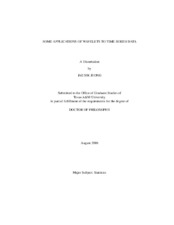| dc.description.abstract | The objective of this dissertation is to develop a suitable statistical methodology for parameter
estimation in long memory process. Time series data with complex covariance
structure are shown up in various fields such as finance, computer network, and econometrics.
Many researchers suggested the various methodologies defined in different domains:
frequency domain and time domain. However, many traditional statistical methods are not
working well in complicated case, for example, nonstationary process. The development of
the robust methodologies against nonstationarity is the main focus of my dissertation. We
suggest a wavelet-based Bayesian method which shares good properties coming from both
wavelet-based method and Bayesian approach. To check the robustness of the method, we
consider ARFIMA(0, d, 0) with linear trend. Also, we compare the result of the method
with that of several existing methods, which are defined in different domains, i.e. time
domain estimators, frequency domain estimators. Also, we apply the method to functional
magnetic resonance imaging (fMRI) data to find some connection between brain activity
and long memory parameter.
Another objective of this dissertation is to develop a wavelet-based denoising technique
when there is heterogeneous variance noise in high throughput data, especially protein
mass spectrometry data. Since denoising technique pretty much depends on threshold
value, it is very important to get a proper threshold value which involves estimate of standard deviation. To this end, we detect variance change point first and get suitable threshold
values in each segment. After that, we apply local wavelet thresholding to each segment,
respectively. For comparison, we consider several existing global thresholding methods. | en |


